Sitting Bull was one of the most famous Native Americans of the 19th Century. One of the victors at the famous Battle of Little Bighorn, he also found fame as a touring performer. He was one of the most vocal opponents of American settlement of the West, and it was his activism that incidentally resulted in his death. 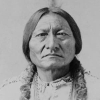
He was born into the Hunkpapa Lakota tradition in 1831 in the Dakota Territory. Many historians say that his birth name was Jumping Badger and that his childhood nickname was "Slow," given him because of his deliberate nature. He got his most famous name from his father, the result of a show of a bravery during his first raiding party. An Anglicization of his Lakota name is Tatanka Yotanka. The name in his native language meant the equivalent of "buffalo bull sitting." The English version became Sitting Bull. (His father was then called Jumping Bull.) Like many of his Lakota Sioux brothers and sisters, Sitting Bull did not appreciate the increasing number of European settlers who were moving in to live all around them. Sitting Bull was one to take action, and, beginning in 1863, he took up arms against these American settlers and the soldiers who supported them. He found a kindred spirit in Red Cloud, who was also resisting the encroachment of American settlers, and joined the Oglala leader's armed struggle in what is now Montana but did not support his fellow Lakota leader when he signed a treaty with "the enemy" in 1868 and agreed to live on a reservation. Sitting Bull considered to rise in the esteem of his people and in 1869 was looked on as the Supreme Chief of the Lakota Sioux. He it was who led resistance to an order from the U.S. Government in 1874 for all Sioux to vacate the Black Hills because gold had been discovered there. That land was what the 1868 Fort Laramie Treaty had guaranteed as belonging to the Sioux. During one brief conflict, Sitting Bull came face to face with his future enemy, George Armstrong Custer, then providing military accompaniment for a railroad survey. 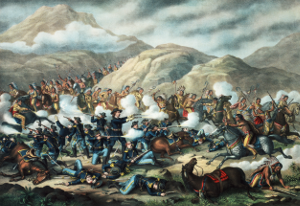
In 1875, a large number of members of several tribes joined together for a Sun Dance. Sitting Bull performed a sustained ritual during this gathering and a vision that his fellow warriors would gain a great victory over their enemies. His vision was seen to be a prophecy come true the following year when he and Crazy Horse were among the leaders of the victors at the Battle of Little Bighorn, cutting down to a man the small force led by the brash Custer. The U.S. Army found the results of that battle shocking and sent larger and larger waves of soldiers to confront Sitting Bull and others. He responded by taking a number of his followers north, into Canada. They lived near Wood Mountain for four years, returning to the U.S. because of a lack of food and opportunity. Sitting Bull and nearly 200 of his family and followers surrendered to Major David H. Brotherton at Fort Buford. They were eventually sent to Fort Yates, next to the Standing Rock Agency. After a brief transit to Fort Randall and back, they returned. 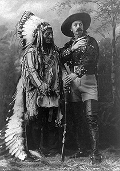
That was not the end of Sitting Bull's story, though. In 1884, a promoter named Alvaren Allen asked permission for Sitting Bull to go on tour, as the star of his own show, the Sitting Bull Connection. Allen got the necessary permission, Sitting Bull agreed to go, and he toured parts of Canada and the northern U.S., at one stage meeting the famed markswoman Annie Oakley. The two took a great liking to each other, and he later gained permission to join her as part of Buffalo Bill's Wild West show. He earned $50 a week and was very popular. After four months, he returned to the reservation. 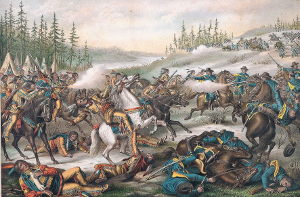
In 1889, Sitting Bull associated with the Ghost Dance movement, a group of Native Americans who increasingly advocated for speaking out, if not rebelling, against white authorities. An officer in charge at Fort Yates, fearing that Sitting Bull would be leading an armed uprising, ordered his arrest, to take place at dawn on December 15. The famed Sioux leader resisted being taken into custody, others came to his aid, shots were fired, and 16 people died, including Sitting Bull himself. He had at one time survived a bullet's going clean through his hip; he could not survive a bullet fired into his head. He was married three times and had nine children in all. He was often thought of as a warrior but was much more prominent as a medicine man, a leader of men, than as a paragon of violence. He came to symbolize the spirited yet futile Native American resistance to Manifest Destiny. Among the famous things he said were these:
|
|
Social Studies for Kids
copyright 2002–2025
David White



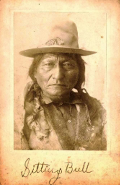 "It does not take many words to tell the truth."
"It does not take many words to tell the truth."
